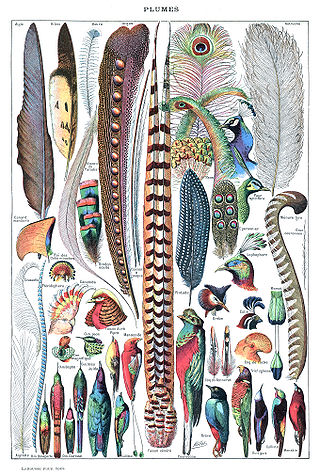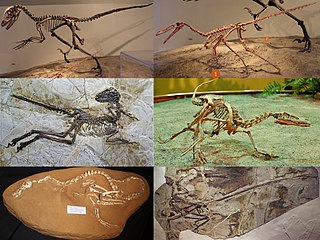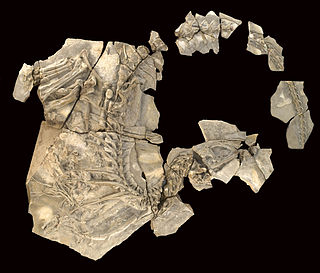The pennaceous feather is a type of feather present in most modern birds and in some other species of maniraptoriform dinosaurs. [1]
The pennaceous feather is a type of feather present in most modern birds and in some other species of maniraptoriform dinosaurs. [1]
A pennaceous feather has a stalk or quill. [2] Its basal part, called a calamus, is embedded in the skin. The calamus is hollow and has pith formed from the dry remains of the feather pulp, and the calamus opens below by an inferior umbilicus and above by a superior umbilicus. [2] The stalk above the calamus is a solid rachis having an umbilical groove on its underside. Pennaceous feathers have a rachis with vanes or vaxillum spreading to either side. These vanes are composed of a high number of flattened barbs , that are connected to one another with barbules .
The barbules are tiny strands that criss-cross on the flattened sides of the barbs. This forms a miniature velcro-like mesh that holds all the barbs together, stabilizing the vanes. [3]
Pennaceous feathers on the wing, and elsewhere that stresses related to flight or other activities are high, are accordingly attached especially strongly. This strong attachment is accomplished by ligaments under the skin, which in some birds and other feathered dinosaurs results in raised bumps or marks along the rear forelimb bone (ulna). These bumps, called quill knobs (ulnar papillae), are often used as an indirect indication of strongly-attached forelimb feathers in fossil species, and can also indirectly indicate the number of secondary remiges in a given specimen. [4] [5]
Flight feathers (remiges and rectrices) are specialized types of pennaceous feathers, adapted for high loadings and often strongly asymmetric for improved flight performance.

Feathers are epidermal growths that form a distinctive outer covering, or plumage, on both avian (bird) and some non-avian dinosaurs and other archosaurs. They are the most complex integumentary structures found in vertebrates and a premier example of a complex evolutionary novelty. They are among the characteristics that distinguish the extant birds from other living groups.

Dromaeosauridae is a family of feathered coelurosaurian theropod dinosaurs. They were generally small to medium-sized feathered carnivores that flourished in the Cretaceous Period. The name Dromaeosauridae means 'running lizards', from Greek δρομαῖος (dromaîos), meaning 'running at full speed', 'swift', and σαῦρος (saûros), meaning 'lizard'. In informal usage, they are often called raptors, a term popularized by the film Jurassic Park; several genera include the term "raptor" directly in their name, and popular culture has come to emphasize their bird-like appearance and speculated bird-like behavior.

Caudipteryx is a genus of peacock-sized theropod dinosaurs that lived in the Barremian age of the early Cretaceous. They were feathered and extremely birdlike in their overall appearance, to the point that some paleontologists think it was a bird. Two species have been described: C. zoui, in 1998, and C. dongi, in 2000.

Shuvuuia is a genus of bird-like theropod dinosaur from the late Cretaceous period of Mongolia. It is a member of the family Alvarezsauridae, small coelurosaurian dinosaurs which are characterized by short but powerful forelimbs specialized for digging. The type species is Shuvuuia deserti, or "desert bird". The name Shuvuuia is derived from the Mongolian word shuvuu (шувуу) meaning "bird".

Maniraptora is a clade of coelurosaurian dinosaurs which includes the birds and the non-avian dinosaurs that were more closely related to them than to Ornithomimus velox. It contains the major subgroups Avialae, Dromaeosauridae, Troodontidae, Oviraptorosauria, and Therizinosauria. Ornitholestes and the Alvarezsauroidea are also often included. Together with the next closest sister group, the Ornithomimosauria, Maniraptora comprises the more inclusive clade Maniraptoriformes. Maniraptorans first appear in the fossil record during the Jurassic Period, and survive today as living birds.

A feathered dinosaur is any species of dinosaur possessing feathers. That includes all species of birds, but there is a hypothesis that many, if not all non-avian dinosaur species also possessed feathers in some shape or form. That theory has been challenged by some research.

Pedopenna is a genus of small, feathered, maniraptoran dinosaur from the Daohugou Beds in China. It is possibly older than Archaeopteryx, though the age of the Daohugou Beds where it was found is debated. A majority of studies suggest that beds probably date from between the late Middle Jurassic and early Late Jurassic Period.

Jinfengopteryx is a genus of maniraptoran dinosaur. It was found in the Qiaotou Member of the Huajiying Formation of Hebei Province, China, and is therefore of uncertain age. The Qiaotou Member may correlate with the more well-known Early Cretaceous Yixian Formation, and so probably dates to around 122 Ma ago.

Incisivosaurus is a genus of small, probably herbivorous theropod dinosaurs from the early Cretaceous Period of what is now the People's Republic of China. The first specimen to be described, IVPP V13326, is a skull that was collected from the lowermost levels of the Yixian Formation in the Sihetun area, near Beipiao City, in western Liaoning Province. The most significant, and highly unusual, characteristic of this dinosaur is its apparent adaptation to an herbivorous or omnivorous lifestyle. It was named for its prominent, rodent-like front teeth, which show wear patterns commonly found in plant-eating dinosaurs. The specific name gauthieri honors Dr. Jacques Gauthier, a pioneer of the phylogenetic method of classification.

Flight feathers are the long, stiff, asymmetrically shaped, but symmetrically paired pennaceous feathers on the wings or tail of a bird; those on the wings are called remiges, singular remex, while those on the tail are called rectrices, singular rectrix. The primary function of the flight feathers is to aid in the generation of both thrust and lift, thereby enabling flight. The flight feathers of some birds perform additional functions, generally associated with territorial displays, courtship rituals or feeding methods. In some species, these feathers have developed into long showy plumes used in visual courtship displays, while in others they create a sound during display flights. Tiny serrations on the leading edge of their remiges help owls to fly silently, while the extra-stiff rectrices of woodpeckers help them to brace against tree trunks as they hammer on them. Even flightless birds still retain flight feathers, though sometimes in radically modified forms.

Anchiornis is a genus of small, four-winged paravian dinosaurs, with only one known species, the type species Anchiornis huxleyi, named for its similarity to modern birds. The Latin name Anchiornis derives from a Greek word meaning "near bird", and huxleyi refers to Thomas Henry Huxley, a contemporary of Charles Darwin.

The following outline is provided as an overview of and topical guide to birds:

Concavenator is an extinct carcharodontosaurid theropod dinosaur that lived approximately 130 million years ago during the Early Cretaceous period. The type species is C. corcovatus. Concavenator corcovatus means "Cuenca hunter with a hump". The fossil was discovered in the Las Hoyas fossil site of Spain by paleontologists José Luis Sanz, Francisco Ortega, and Fernando Escaso from the Autonomous University of Madrid and the National University of Distance Education.

Pennaraptora is a clade defined as the most recent common ancestor of Oviraptor philoceratops, Deinonychus antirrhopus, and Passer domesticus, and all descendants thereof, by Foth et al., 2014.

Dakotaraptor is a potentially chimaeric genus of large dromaeosaurid theropod dinosaur that lived in western North America during the Late Cretaceous period. The remains have been found in the Maastrichtian-aged Hell Creek Formation, dated to the very end of the Mesozoic era, making Dakotaraptor one of the last surviving dromaeosaurids. The remains of D. steini were discovered in a multi-species bonebed. Elements of the holotype and referred specimens were later found to belong to trionychid turtles and further analysis of potential non-dromaeosaurid affinities of the holotype and referred material have not yet been conducted. Phylogenetic analyses of D. steini place it in a variety of positions within Dromaeosauridae.
Feather development occurs in the epidermal layer of the skin in birds. It is a complicated process involving many steps. Once the feathers are fully developed, there are six different types of feathers: contour, flight, down, filoplumes, semiplumes, and bristle feathers. Feathers were not originally meant for flight. The exact reason why feathers evolved is still unknown. Birds are thought to be descendants of dinosaurs and new technology using melanosomes found in dinosaur fossils has shown that certain dinosaurs that could not fly had feathers.

The following is a glossary of common English language terms used in the description of birds—warm-blooded vertebrates of the class Aves and the only living dinosaurs, characterized by feathers, the ability to fly in all but the approximately 60 extant species of flightless birds, toothless, beakedjaws, the laying of hard-shelled eggs, a high metabolic rate, a four-chambered heart and a strong yet lightweight skeleton.

Jianianhualong is a genus of troodontid theropod dinosaur from the Early Cretaceous of China. It contains a single species, Jianianhualong tengi, named in 2017 by Xu Xing and colleagues based on an articulated skeleton preserving feathers. The feathers at the middle of the tail of Jianianhualong are asymmetric, being the first record of asymmetrical feathers among the troodontids. Despite aerodynamic differences from the flight feathers of modern birds, the feathers in the tail vane of Jianianhualong could have functioned in drag reduction whilst the animal was moving. The discovery of Jianianhualong supports the notion that asymmetrical feathers appeared early in the evolutionary history of the Paraves.

Serikornis is a genus of small, feathered anchiornithid dinosaur from the Upper Jurassic Tiaojishan Formation of Liaoning, China. It is represented by the type species Serikornis sungei.